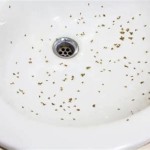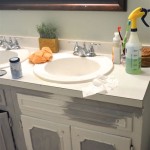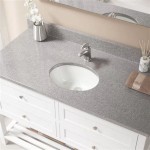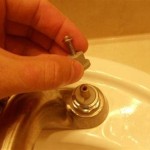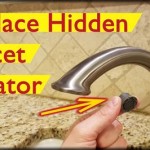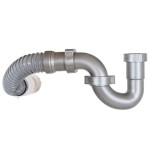How To Remove Hard Water Spots From Bathroom Fixtures
Hard water, characterized by a high mineral content, predominantly calcium and magnesium, poses a persistent challenge in many households. While not detrimental to health, it leaves unsightly residues, commonly known as hard water spots, on various surfaces, particularly bathroom fixtures. These spots, if left unaddressed, can accumulate over time, becoming increasingly difficult to remove and potentially etching into the surface of the fixture. Understanding the nature of hard water and employing appropriate cleaning techniques are crucial for maintaining the aesthetic appeal and longevity of bathroom fixtures.
The formation of hard water spots occurs when hard water evaporates, leaving behind the dissolved minerals as a solid deposit. The severity of the spotting depends on the water hardness level and the frequency with which water comes into contact with the fixture. Showers, faucets, toilets, and even glass shower doors are particularly susceptible due to their constant exposure to water. These spots can range in color from a cloudy white to a more opaque, hardened deposit, often clinging stubbornly to the surface.
Regular cleaning is essential to prevent the buildup of hard water spots. However, standard cleaning products often lack the necessary acidity to effectively dissolve the mineral deposits. Therefore, specific cleaning solutions and methods are required to tackle this common household problem. This article provides a comprehensive guide on identifying, preventing, and removing hard water spots from various bathroom fixtures, ensuring a clean and sparkling bathroom environment.
Identifying Hard Water Spots and Assessing Fixture Material
Before embarking on the cleaning process, proper identification of hard water spots is paramount. These spots typically appear as white or gray residues, often circular or irregular in shape, clinging to the surface of the fixture. They may feel rough to the touch, especially when compared to a clean surface. On glass shower doors, hard water spots can create a hazy or cloudy appearance, obstructing visibility. Differentiating hard water spots from other types of stains, such as soap scum or mildew, is crucial for selecting the appropriate cleaning solution.
Accurately assessing the material of the fixture is equally important. Bathroom fixtures are commonly made from various materials, including chrome, stainless steel, porcelain, glass, and plastic. Each material reacts differently to cleaning agents. Using an abrasive cleaner on a delicate surface, such as polished chrome, can result in scratches and permanent damage. Conversely, a mild cleaner may not be effective in removing stubborn hard water spots from a more durable surface like porcelain. Consult the manufacturer's recommendations or conduct a spot test on an inconspicuous area before applying any cleaning solution to the entire fixture.
Chrome fixtures, widely used for faucets and showerheads, are susceptible to scratching if subjected to abrasive cleaners. Stainless steel, while more durable, can still be damaged by harsh chemicals. Porcelain, commonly found in toilets and sinks, is relatively resilient but can be stained by acidic solutions if left in contact for extended periods. Glass shower doors require gentle cleaning to avoid etching or scratching. Plastic components are typically the most sensitive and should be cleaned with mild, non-abrasive solutions.
Effective Cleaning Solutions for Removing Hard Water Spots
Numerous effective cleaning solutions can be used to remove hard water spots, ranging from readily available household ingredients to commercially formulated products. The choice of solution depends on the severity of the spotting and the material of the fixture being cleaned.
Vinegar, specifically white vinegar, is a widely recognized and effective natural cleaning agent for removing hard water spots. Its acidity dissolves the mineral deposits without causing significant damage to most bathroom fixtures. To use vinegar, dilute it with an equal amount of water and apply the solution to the affected area using a spray bottle or sponge. Allow the solution to sit for 15-30 minutes, depending on the severity of the spotting. For stubborn spots, a longer soaking time may be necessary. After soaking, scrub the area with a non-abrasive sponge or cloth and rinse thoroughly with clean water. Dry the fixture with a clean towel to prevent new spots from forming.
Lemon juice, another natural acidic cleaner, offers a similar cleaning action to vinegar. Its pleasant scent makes it a popular alternative. Lemon juice can be applied directly to the hard water spots or diluted with water. The application process is identical to that of vinegar. After soaking and scrubbing, rinse the fixture thoroughly and dry with a clean towel.
Baking soda, a mild abrasive, can be used to remove stubborn hard water spots that are resistant to vinegar or lemon juice. To use baking soda, create a paste by mixing it with a small amount of water. Apply the paste to the affected area and gently scrub with a non-abrasive sponge or cloth. Rinse thoroughly with clean water and dry with a clean towel. Avoid using excessive force when scrubbing to prevent scratching the fixture's surface.
Commercially formulated hard water stain removers are also available. These products typically contain stronger acids or chelating agents designed to dissolve mineral deposits more effectively. When using commercial cleaners, carefully follow the manufacturer's instructions and wear appropriate protective gear, such as gloves and eye protection. Ensure adequate ventilation in the bathroom during use and avoid prolonged contact with the skin. Test the cleaner on an inconspicuous area before applying it to the entire fixture.
Step-by-Step Cleaning Procedures for Specific Fixtures
The specific cleaning procedure may vary depending on the type of fixture being cleaned. While the basic principles remain the same, different fixtures require tailored approaches to ensure effective cleaning and prevent damage.
Showerheads: Mineral buildup can significantly reduce water flow and pressure in showerheads. To clean a showerhead, remove it from the shower arm, if possible. Submerge the showerhead in a solution of equal parts vinegar and water for several hours or overnight. For showerheads that cannot be removed, fill a plastic bag with the vinegar solution and secure it around the showerhead with a rubber band, ensuring the showerhead is fully submerged. After soaking, remove the showerhead and scrub away any remaining mineral deposits with a toothbrush or small brush. Rinse thoroughly with clean water and reattach the showerhead to the shower arm.
Faucets: Hard water spots often accumulate around the base of faucets and on the faucet handles. To clean faucets, apply a vinegar or lemon juice solution to the affected areas using a sponge or cloth. Let the solution sit for 15-30 minutes, then scrub with a non-abrasive sponge or cloth. For hard-to-reach areas, use a toothbrush or cotton swab. Rinse thoroughly with clean water and dry with a clean towel. For stubborn spots, create a baking soda paste and apply it to the area, scrubbing gently before rinsing.
Toilets: Hard water stains can appear in the toilet bowl, particularly around the water line. To clean the toilet bowl, pour a cup of vinegar into the bowl and let it sit overnight. In the morning, scrub the bowl with a toilet brush and flush. For stubborn stains, use a pumice stone specifically designed for toilet bowls. Wet the pumice stone and gently rub it against the stains, being careful not to scratch the porcelain. Rinse the bowl thoroughly after scrubbing.
Glass Shower Doors: Hard water spots on glass shower doors can create a hazy or cloudy appearance. To clean glass shower doors, spray a vinegar solution onto the glass and let it sit for 15-30 minutes. Wipe the glass with a squeegee or a microfiber cloth. For stubborn spots, use a mixture of baking soda and water to create a paste and apply it to the affected areas. Scrub gently with a non-abrasive sponge and rinse thoroughly with clean water. Dry the glass with a clean towel or squeegee to prevent new spots from forming. Consider applying a water repellent product specifically designed for glass shower doors to help prevent future spotting.
Stainless Steel Fixtures: For stainless steel fixtures, avoid using abrasive cleaners or steel wool, as these can scratch the surface. Instead, use a mild dish soap and water solution or a commercially formulated stainless steel cleaner. Apply the cleaner to a soft cloth and wipe the fixture, following the grain of the steel. Rinse thoroughly with clean water and dry with a clean towel. To prevent water spots, consider using a stainless steel polish after cleaning.
Preventive Measures to Minimize Hard Water Spots
While cleaning effectively removes existing hard water spots, implementing preventive measures can significantly reduce their formation and minimize the need for frequent cleaning. Several strategies can be employed to mitigate the effects of hard water and maintain the cleanliness of bathroom fixtures.
Water Softeners: Installing a water softener is the most effective way to address the root cause of hard water spots. Water softeners remove the calcium and magnesium minerals from the water supply, preventing the formation of hard water scale. While the initial investment can be significant, the long-term benefits include reduced cleaning effort, extended lifespan of appliances, and improved water quality for bathing and washing.
Regular Wiping and Drying: After each use of the sink or shower, wiping down the fixtures with a clean, dry towel can prevent water from evaporating and leaving behind mineral deposits. This simple habit can significantly reduce the buildup of hard water spots and make cleaning less frequent and less demanding. Keep a squeegee in the shower to quickly remove water from the shower doors and walls after each use.
Protective Coatings: Applying a water repellent coating to bathroom fixtures can create a barrier that prevents water from adhering to the surface. These coatings, often available as sprays or wipes, cause water to bead and roll off, minimizing the chance of mineral deposits forming. Reapply the coating regularly according to the manufacturer's instructions.
Shower Filters: Installing a shower filter can help reduce the mineral content of the water, although not as effectively as a whole-house water softener. Shower filters typically use activated carbon or other filtration media to remove some of the calcium and magnesium from the water. While they may not completely eliminate hard water spots, they can help reduce their severity.
Proper Ventilation: Ensuring adequate ventilation in the bathroom can help reduce humidity and promote faster drying of surfaces. Use the exhaust fan during and after showering to remove moisture from the air. This can help prevent water from lingering on fixtures and leaving behind mineral deposits.
By understanding the nature of hard water, employing appropriate cleaning techniques, and implementing preventive measures, one can effectively manage hard water spots and maintain the cleanliness and aesthetic appeal of bathroom fixtures. Consistent effort and proactive strategies are key to creating a sparkling and inviting bathroom environment.

5 Methods For Removing Hard Water Stains Bob Hoegler Plumbing

Easy Way To Remove Hard Water Stains Domestically Speaking

How To Remove Hard Water Stains Puracy

How To Prevent Water Spots On Chrome The Happier Homemaker

Hard Water Stains Take Them Off And Keep I Sustainable Solutions

How To Remove Hard Water Stains From Glass Shower Doors Wd 40

How To Remove Hard Water Stains

Easy Way To Remove Hard Water Stains Domestically Speaking

How To Remove Hard Water Stains From The Bathroom Cleanipedia Ph

Diy Limescale Hard Water Stain Solutions Aquarius Home Services
Related Posts
